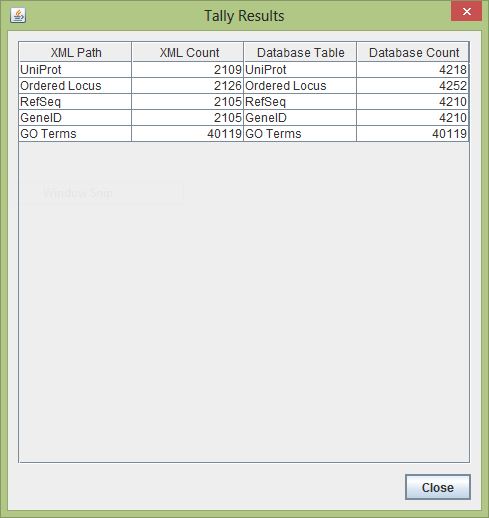Difference between revisions of "TATK E4: TIGR4 Testing Report"
(→TallyEngine) |
(→OriginalRowCounts Comparison) |
||
| Line 50: | Line 50: | ||
==OriginalRowCounts Comparison== | ==OriginalRowCounts Comparison== | ||
| + | |||
| + | [[Image:20131126 OGrowcounts tATK TIGR4 E4 AJV.PNG]] | ||
| + | |||
Within the .gdb file, look at the OriginalRowCounts table to see if the database has the expected tables with the expected number of records. Compare the tables and records with a benchmark .gdb file. | Within the .gdb file, look at the OriginalRowCounts table to see if the database has the expected tables with the expected number of records. Compare the tables and records with a benchmark .gdb file. | ||
Revision as of 18:51, 26 November 2013
Export Information
Version of GenMAPP Builder: 2.0b71 modified and distributed 2013NOV25 and version not yet updated
- Database called: tATK_TIGR4_2013NOV25
Computer on which export was run: Tauras' Personal Computer
Postgres Database name: tATK_TIGR4_2013NOV25
UniProt XML filename: 20131118_UniProtXML_tATK_TIGR4_TPV.xml
- UniProt XML version: UniProt Release 2013_11; 2013Nov13
- Time taken to import: 3.15min
GO OBO-XML filename: 20131120_OBOXML_tATK_TPV.obo-xml
- GO OBO-XML version: 2013Nov20
- Time taken to import: 10.59min
- Time taken to process: 9.25min
GOA filename: 20131118_GOA_tATK_TIGR4_TPV.goa
- GOA version: 2013Nov12 14:49
- Time taken to import: 0.03min
Name of .gdb file: 20131125_E4_tATK_TIGR4.gdb
- Time taken to export .gdb: less than 1 hour
- Started at 22:53
- Finished by 23:50
- Upload your file and link to it here. Media:20131125_E4_tATK_TIGR4.gdb
Note: There were no updates to files since last I-E cycle
TallyEngine
- ran/uploaded by Alina via Tauras's computer
Run the TallyEngine in GenMAPP Builder and record the number of records for UniProt and GO in the XML data and in the PostgreSQL databases (or you can upload and link to a screenshot of the results).
Using XMLPipeDB match to Validate the XML Results from the TallyEngine
Follow the instructions found on this page to run XMLPipeDB match.
Are your results the same as you got for the TallyEngine? Why or why not?
Using SQL Queries to Validate the PostgreSQL Database Results from the TallyEngine
Follow the instructions on this page to query the PostgreSQL Database.
OriginalRowCounts Comparison
Within the .gdb file, look at the OriginalRowCounts table to see if the database has the expected tables with the expected number of records. Compare the tables and records with a benchmark .gdb file.
Benchmark .gdb file: (for the Week 9 Assignment, use the "Vc-Std_External_20101022.gdb" as your benchmark, downloadable from here.
Copy the OriginalRowCounts table and paste it here:
Note:
Visual Inspection
Perform visual inspection of individual tables to see if there are any problems.
- Look at the Systems table. Is there a date in the Date field for all gene ID systems present in the database?
- Open the UniProt, RefSeq, and OrderedLocusNames tables. Scroll down through the table. Do all of the IDs look like they take the correct form for that type of ID?
Note:
.gdb Use in GenMAPP
Note:
Putting a gene on the MAPP using the GeneFinder window
- Try a sample ID from each of the gene ID systems. Open the Backpage and see if all of the cross-referenced IDs that are supposed to be there are there.
Note:
Creating an Expression Dataset in the Expression Dataset Manager
- How many of the IDs were imported out of the total IDs in the microarray dataset? How many exceptions were there? Look in the EX.txt file and look at the error codes for the records that were not imported into the Expression Dataset. Do these represent IDs that were present in the UniProt XML, but were somehow not imported? or were they not present in the UniProt XML?
Note:
Coloring a MAPP with expression data
Note:
Running MAPPFinder
Note:
Compare Gene Database to Outside Resource
The OrderedLocusNames IDs in the exported Gene Database are derived from the UniProt XML. It is a good idea to check your list of OrderedLocusNames IDs to see how complete it is using the original source of the data (the sequencing organization, the MOD, etc.) Because UniProt is a protein database, it does not reference any non-protein genome features such as genes that code for functional RNAs, centromeres, telomeres, etc.
Template
| Alina's User Page | Kevin's User Page | Tauras's User Page |
| Biological Databases Class Page | Gene Database Project | Gene Database Project Report Guidelines |
- Import Export Cycle 1: tATK Export One: TIGR4 Testing Report
- Import Export Cycle 2: tATK E2: TIGR4 Testing Report
- Import Export Cycle 3: tATK E3: TIGR4 Testing Report
- Import Export Cycle 4: tATK E4: TIGR4 Testing Report
| Project Roles: | Project Manager | Coder | GenMAPP User | Quality Assurance |

